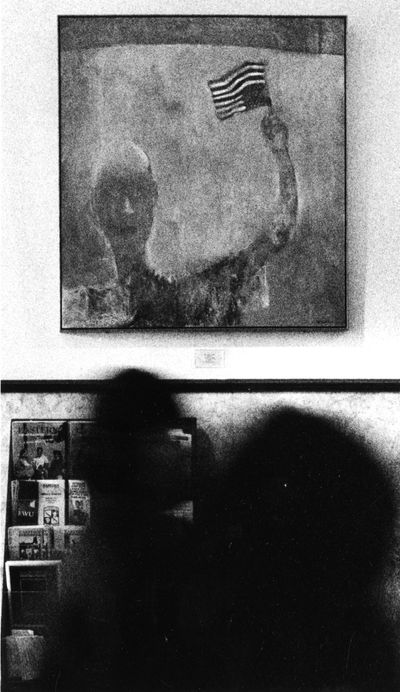This column reflects the opinion of the writer. Learn about the differences between a news story and an opinion column.
Spin Control: Disrespect for Old Glory in the eye of the beholder

When reports of an upside-down flag flying in the yard of a Supreme Court justice hit the news last week, it reinforced a lesson learned 35 years ago from a local controversy.
The lesson? Anything one does with a flag beyond flying it right-side up at the top of a pole will be labeled as disrespectful by someone. But like beauty, respect for the flag is in the eye of the beholder.
People who agree with Justice Samuel Alito and his conservative stances seem inclined to give him a break the 2021 incident in which an inverted American flag flew over his front yard for several days after the Jan. 6 riot at the Capitol. They’ll probably accept the explanation Alito gave the New York Times, agreeing that his wife had probably had cause to fly in response to harassing comments from neighbors, even if she didn’t under the Flag Code, and he had nothing to do with it.
Those who disagree with him have noted that some people who stormed the Capitol carried an inverted American flag. They have demanded he step away from any case tied to that Jan. 6 specific incident and possibly any case connected to disputes over the 2020 election.
Alito’s flag-flying may have temporarily reversed the polarity usually seen among American vexillophiles – a fancy name for flag lovers – who tend to have conservative views on flying the Stars and Stripes that often carry over into conservatism in general.
In the ’60s, for example, the “America Love it or Leave It” crowd were incensed when protesters sewed small American flags on their jackets, noting that the Flag Code says it should not be worn as clothing.
That criticism seemed to stop when military and law enforcement uniforms began sporting flag patches, and self-styled patriots followed suit. These days one might see the widest variety of Star-Spangled clothing at a Trump rally.
American flags fly from the antennas of cars and the back of pickups , and adorn the backs of semis, in all kinds of weather. Crossing the state last week on Interstate 90, I saw one attached to the far end of a center-pivot irrigation system that was circling what I think was a hay field, (although I’m admittedly no expert in agronomy). The wind-whipped flag was tattered and the field of stars had faded from navy to a robin’s egg blue, possibly from constantly catching a stream of water from a sprinkler head.
It was, however, right-side up, so apparently the farmer was not in distress.
Longtime Spokane residents might recall that a painting of a farmer holding inverted American flag sparked a brief but vocal controversy in 1989. The painting, titled “The Patriot” by local artist Mel McCuddin, was hanging in Eastern Washington University’s Showalter Hall.
Some EWU workers who didn’t like the imagery began circulating a petition to take it down because of what they deemed were unpatriotic and negative connotations. The local office of the American Legion was so incensed about the display of an inverted flag it sent a resolution to its state and local offices calling for the painting’s removal. A few days after a photo of the painting appeared on the front page of The Spokesman-Review, the letters to the editor column were partially filled with missives criticizing the painting – and the paper for running the picture.
McCuddin was surprised by the fuss. He’d shown “The Patriot” in two exhibitions since painting it in 1985 and never had any complaints.
The painting was trying to convey his feeling that American farmers are in trouble. “From what I read, a lot of them are losing land that generations have lived on,” he said.
To which a Flag Code expert for the local Legion office replied: “The farmers in this area are not in that dire distress and they are not in battle. It’s illegal to fly the flag upside down.”
The painting shouldn’t just be taken down, it should be disposed of like all nonusable flags, she said. By burning it.
At the risk of sounding argumentative, in the late 1980s, farm bankruptcies nationwide were higher than any time since the Great Depression and Eastern Washington farmers weren’t immune.
To their credit, EWU officials did not take the painting down. They had planned to move it as part of a regular rotation of art from the university foundation collection, but decided to keep it in Showalter Hall for the rest of the year to avoid looking like they were “knuckling under.”
The Alito household reportedly stopped flying the inverted flag after a few days, but apparently not because of any knuckling under. They flew the Revolutionary War’s “Appeal to Heaven” flag at their beach home last summer, which may have connections to Christian nationalism but at least does not run afoul of the Flag Code.
In passing
Long-time bar-owner, musician and one-time mayoral candidate Dave Albertini died this month at 79.
While probably best known for his ownership of The Skylark bar across from the Ridpath Hotel, where he entertained patrons with his trumpet playing and singing, Albertini made a bid for Spokane mayor in 1985.
He was sometimes described as a “colorful candidate.” While that’s often a veiled pejorative for a candidate with bizarre theories or unusual traits, in Albertini’s case it was just an apt description of a guy who stood out from the other candidates in the race who were more experienced as politicians but nowhere near as entertaining.
Albertini finished fourth in the 1985 primary, with about 11% of the vote behind Councilwoman Vicki McNeill, former Councilwoman Margaret Leonard and former Councilman Bob Andren. McNeill later beat Leonard in the general.